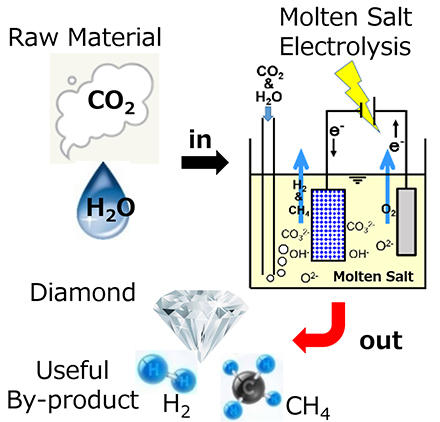Integrated Research Center for Carbon Negative Science
Integrated Research Center for Carbon Negative Science
Professor : Toshiyuki Nohira
Program-Specific Associate Professor : Keiko Kondo
Program-Specific Assistant Professor : Surachada CHUAYCHOB
Program-Specific Assistant Professor : Alisha YADAV
We are working on the control of charged particles by controlling strong magnetic fields precisely, and on the clarifying of energy and particle transport phenomena in magnetically confined fusion plasmas, aiming at new ways of utilizing energy on a wide range of spatio-temporal scales.
https://icans.iae.kyoto-u.ac.jp/en/
Production of Useful Substances from Carbon Dioxide Using Molten Salt Electrolysis
The conversion of carbon dioxide into useful substances is expected to contribute to the realization of a carbon-neutral society by 2050. If all the carbon dioxide generated from thermal power plants and steel-making plants is captured and converted into useful substances (Carbon Dioxide Capture and Utilization-CCU), it will greatly contribute to the carbon neutrality of our society. Furthermore, if carbon dioxide is captured from the atmosphere (Direct Air Capture-DAC) and converted into useful substances, it becomes carbon negative, which is even more significant. We have focused on molten salt electrolysis as a new method to convert carbon dioxide into useful substances. When carbon dioxide is injected into molten salt containing oxide ions (O2−), carbonate ions (CO32−) are produced. When they are reduced at the cathode, various types of carbon are produced. Here, we are challenging to produce diamond, which is one of the most valuable allotropes of carbon. We are studying the optimum conditions for diamond formation by varying the temperature, composition of the molten salt, electrolytic potential, and other factors. So far, it has been found that diamond is formed by hydrogen generation from hydroxide ions (OH−) at the same time as carbon is deposited. Since OH− is produced by injecting water into the molten salt containing O2−, diamonds can be synthesized using only carbon dioxide and water as raw materials. The byproducts of this process are amorphous carbon, hydrogen gas, hydrocarbon gases (methane, etc.), and other useful substances, as well as non-toxic oxygen gas, making it a clean electrolysis method that does not emit hazardous substances.

Production of useful substances from carbon dioxide by molten salt electrolysis.
Development of Biological Conversion Processes of Plant Biomass
Carbon dioxide fixation proceeds in nature through photosynthesis by plants, where the carbon dioxide is converted to organic compounds and accumulated. Our society has been developed depending on various chemical products derived from fossil resources. Techniques to produce such chemical products from plant biomass enable long-term fixation of carbon, which accumulates in plants, as chemical products and leads to the realization of negative carbon emission. Lignocellulosic biomass such as wood is promising plant biomass that does not compete with food demands and contains lignin, an aromatic resource alternative to fossil fuels. We are studying enzymes produced by wood-degrading microorganisms to reveal the mechanisms underlying the degradation of polysaccharides and lignin in the lignocellulosic biomass. On the basis of the findings, we are also working on the development of methodologies for separating, decomposing, and modifying each component of lignocellulosic biomass through biological processes using enzymes. Our research aims future development of a sustainable society that incorporates a material production system into the natural carbon cycle system.
 Production of chemical products via biological processes.
Production of chemical products via biological processes.








